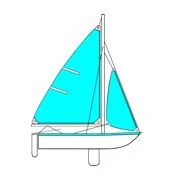If your serious about working the San Juan currents to your advantage you will want to purchase this current atlas, produced by the Canadian Hydrographic Service. The Atlas is available at West Marine as well as many retailers for about $30
To use the Atlas without doing any math, you will also want to purchase an annual page index such as Washburne's Tables for about $7
Some genius's have posted their own index tables online that you may copy for free.
(try this one http://code.borsboom.io/current-atlas-tables/)

Below is a scan of part of one page from the current atlas.
This is confusing so read the next section twice or more.
The Current Atlas consists of about 80 pages, each page is identical, except for the direction and size of the arrows. Each page represents current direction and velocity forecast for one hour of that day. All days and all hours are forecast, some conditions repeat repeat repeat, that's why there are 80 pages and not 8,760, and why you need a page index to locate the correct page. You will only need one Current Atlas (used or new) but you will need a page index for the date of your cruise. An old index table such as the "2009" pictured above is of no use unless your yacht is a time machine.
The page below, was the forecast for July 13, 2011 at 6:00 pm. If you wanted to see the forecast for 5pm, 7pm, or another day, you would look at a different page. (this is similar to tide tables, except with drawings)
The biggest arrows represent current velocity over 2.5 mph, the smallest, under .25 mph.
The arrows point the direction of flow.
Notice the whirlpool (eddy) south of Victoria and off San Juan Island. Notice the current flowing south on east side of Orcas and north on west side of Whidbey.When cruising, having this information handy can save you time and fuel and make the difference whether you get to your planned destination. For instance a boat heading north up Haro Strait near San Juan Island will get a big boost, however by checking the next several hours one would see that the free ride is going to end soon and the train will come roaring back. As a rule of thumb the currents flow north on a flood tide and south on ebb tides but as you can see, rules have exceptions. This forecast is just before the flood tide reverses and becomes ebb, an apt description would be "confused" The confusion will soon end, get your ticket to ride, its free.
This is what the currents looked like on July 13th at 7:49 am, also July 14th at 8:39 am and July15th at 9:26 am. As you can see, your vessel will get a free ride south just about everywhere, but each day at a slightly different time. When planning your passages and your cruise it would be very helpful to consult the Current Atlas first, a simple free ride one week will be the wrong direction the next week. You may want to choose a different departure date.
While were on subject of currents, picture in your mind these big arrows meeting opposing winds and you should then visualize big, steep (dangerous) waves slamming your boat. Then after a few hours the current changes, and all is well in Camelot once again.
this post should be read if big waves bother you >>>wind-versus-current-and-predicting waves
Lately, I have made it part of my cruising to use as little fuel as possible, one cruise we covered about 120 miles over 8 days and used 6 gallons of gas, and most of the fuel was used battling an opposing current between Jones Island and James Island. Unfortunately my schedule dictated the time.



